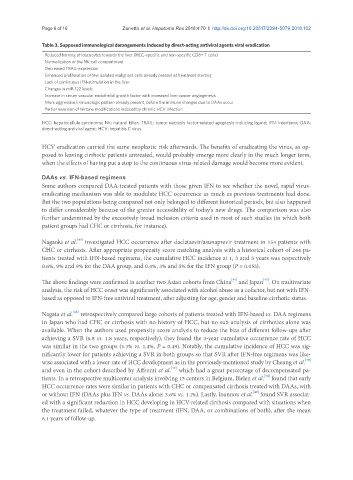Page 786 - Read Online
P. 786
Page 6 of 16 Zanetto et al. Hepatoma Res 2018;4:70 I http://dx.doi.org/10.20517/2394-5079.2018.102
Table 3. Supposed immunological derangements induced by direct-acting antiviral agents viral eradication
Reduced homing of leucocytes towards the liver (HCC-specific and non-specific CD8+ T cells)
Normalization of the NK-cell compartment
Decreased TRAIL-expression
Enhanced proliferation of few isolated malignant cells already present at treatment starting
Lack of continuous IFN-stimulation in the liver
Changes in miR-122 levels
Increase in serum vascular endothelial growth factor with increased liver cancer angiogenesis
More aggressive immunologic pattern already present, before the immune changes due to DAAs occur
Partial reversion of histone modifications induced by chronic HCV infection
HCC: hepatocellula carcinoma; NK: natural killer; TRAIL: tumor necrosis factor-related apoptosis-inducing ligand; IFN: interferon; DAA:
direct-acting antiviral agent; HCV: hepatitis C virus
HCV eradication carried the same neoplastic risk afterwards. The benefits of eradicating the virus, as op-
posed to leaving cirrhotic patients untreated, would probably emerge more clearly in the much longer term,
when the effects of having put a stop to the continuous virus-related damage would become more evident.
DAAs vs. IFN-based regimens
Some authors compared DAA-treated patients with those given IFN to see whether the novel, rapid virus-
eradicating mechanism was able to modulate HCC occurrence as much as previous treatments had done.
But the two populations being compared not only belonged to different historical periods, but also happened
to differ considerably because of the greater accessibility of today’s new drugs. The comparison was also
further undermined by the excessively broad inclusion criteria used in most of such studies (in which both
patient groups had CHC or cirrhosis, for instance).
[43]
Nagaoki et al. investigated HCC occurrence after daclatasvir/asunaprevir treatment in 154 patients with
CHC or cirrhosis. After appropriate propensity score matching analysis with a historical cohort of 244 pa-
tients treated with IFN-based regimens, the cumulative HCC incidence at 1, 3 and 5 years was respectively
0.6%, 9% and 9% for the DAA group, and 0.4%, 3% and 5% for the IFN group (P = 0.053).
[45]
[44]
The above findings were confirmed in another two Asian cohorts from China and Japan . On multivariate
analysis, the risk of HCC onset was significantly associated with alcohol abuse as a cofactor, but not with IFN-
based as opposed to IFN-free antiviral treatment, after adjusting for age, gender and baseline cirrhotic status.
[46]
Nagata et al. retrospectively compared large cohorts of patients treated with IFN-based vs. DAA regimens
in Japan who had CHC or cirrhosis with no history of HCC, but no sub analysis of cirrhotics alone was
available. When the authors used propensity score analysis to reduce the bias of different follow-ups after
achieving a SVR (6.8 vs. 1.8 years, respectively), they found the 3-year cumulative occurrence rate of HCC
was similar in the two groups (3.3% vs. 1.4%, P = 0.49). Notably, the cumulative incidence of HCC was sig-
nificantly lower for patients achieving a SVR in both groups so that SVR after IFN-free regimens was like-
[40]
wise associated with a lower rate of HCC development as in the previously-mentioned study by Cheung et al.
[47]
and even in the cohort described by Affronti et al. which had a great percentage of decompensated pa-
[48]
tients. In a retrospective multicenter analysis involving 15 centers in Belgium, Bielen et al. found that early
HCC occurrence rates were similar in patients with CHC or compensated cirrhosis treated with DAAs, with
[49]
or without IFN (DAAs plus IFN vs. DAAs alone: 3.6% vs. 1.1%). Lastly, Ioannou et al. found SVR associat-
ed with a significant reduction in HCC developing in HCV-related cirrhosis compared with situations when
the treatment failed, whatever the type of treatment (IFN, DAA, or combinations of both), after the mean
6.1 years of follow-up.

